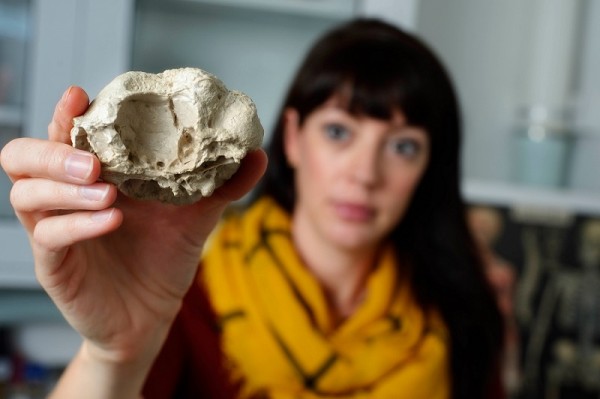By Ana Verayo, | September 23, 2016

College of Science researcher Michelle Stocker holds a cast of Triopticus primus specimen, displaying the area where the animal's left eye was located.
Dinosaurs are some of the most majestic and iconic creatures that ever walked the planet. However, a recent study has revealed that the features, skull shapes, and proportions of dinosaurs were copied from their distant reptile relatives.
In a new study, researchers analyzed an ancient species of an extinct reptile possessing a skull similar to a dinosaur, including its structure and features.
Like Us on Facebook
This reptile, which lived around 230 million years ago, is called the Triopticus primus; this means that this creature existed at least 100 million years before the age of dinosaurs. Its upper skull is thick with distinct dome-shaped features on top of its head that is similar to the Pachycephalosaurus.
During excavations in Otis Chalk County, Texas, scientists were able to uncover fossilized remains of the Triopticus and were also able to compare it with the distinct skull shapes of dinosaurs.
According to paleontologist Michelle Stocker from Virginia Tech, the Triopticus is an extraordinary example of this type of evolutionary convergence between relatives of dinosaurs with crocodylians.
Stocker said that the unique body shapes seen in many dinosaurs evolved millions of years before the Triassic period, some 225 million years ago, to be accurate.
Scientists call this "convergence," when two species that are very distant relatives appear to have evolved a similar shape and appearance separately. This evolutionary phenomenon is apparently very common.
Researchers have presented their latest findings as evidence of convergence; even if it occurred between unexpectedly long periods of time among very diverse groups of reptiles and dinosaurs that thrived during the Triassic and Jurassic periods.
The body shape convergence of the Triopticus is similar to the dome-headed dinosaurs, although they are 100 million years apart.
Other than the Triopticus, CT scans of the other fauna also showed evidence of convergence, such as armored plates from ankylosaurs, elongated snouts of the spinosaurus and toothless beaks seen from ornithomimosaurs.
This study has been published in the journal, Current Biology.
-
Use of Coronavirus Pandemic Drones Raises Privacy Concerns: Drones Spread Fear, Local Officials Say

-
Coronavirus Hampers The Delivery Of Lockheed Martin F-35 Stealth Fighters For 2020

-
Instagram Speeds Up Plans to Add Account Memorialization Feature Due to COVID-19 Deaths

-
NASA: Perseverance Plans to Bring 'Mars Rock' to Earth in 2031

-
600 Dead And 3,000 In The Hospital as Iranians Believed Drinking High-Concentrations of Alcohol Can Cure The Coronavirus

-
600 Dead And 3,000 In The Hospital as Iranians Believed Drinking High-Concentrations of Alcohol Can Cure The Coronavirus

-
COVID-19: Doctors, Nurses Use Virtual Reality to Learn New Skills in Treating Coronavirus Patients







